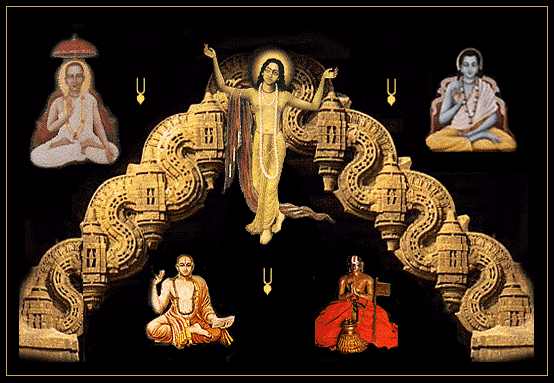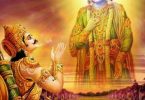Question:
It is sometimes said that Sri Caitanya Mahaprabhu accepted two teachings from each of the four Sampradayas and in this way the unity of the four Sampradayas is embodied within the teachings of Sri Caitanya Mahaprabhu. It is also said that Srila Bhaktisiddhanta Saraswati Thakur taught and gave emphasis to this particular point, for the sake of unifying the four Sampradayas.
Which of the following two options is correct?
- Sri Chaitanya Mahaprabhu actually selected two teachings from each of the four Sampradayas.
-OR-
- Caitanya Mahaprabhu’s teachings cover these four Sampradayas’ teachings, embedded within His teachings by divine arrangement, not by selection.
Answer by Romapada Swami:
There is some history involved in this. First of all, see the two verses taken from Padma Purana which were expanded upon by Baladev Vidyabhushan in his writing Premeya Ratnavali:
Padma Puräna
cited by Srila Baladev Vidyabhushan in Prameya Ratnävalé 5-6.
sampradäya vihénä ye
manträs te niñphalä matäù
ataù kalau bhaviñyanti
catväraù sampradäyinaù
çré-brahma-rudra-sanakä
vaiñëaväù kñiti-pävanäù
catväras te kalau bhävyä
hy utkale puruñottamät
If someone receives a mantra from a guru who doesn’t come in a bona fide sampradäya that mantra will have no potency. Hence in the Age of Kali there will arise four founders of samprädayas, namely Sri, Brahma, Rudra and Sanaka. These four vaiñëavas are the sanctifiers of the earth. Their four respective sampradäyas will arise from the Supreme Personality of Godhead in Utkal [Orissa].
These verses from the Padma Purana are the scriptural basis for the understanding which, in course of time, evolved – regarding the teachings of Lord Caitanya.
The three primary authorized texts on Lord Caitanya Mahaprabhu’s life (namely, Caitanya Caritamrta, Caitanya Bhagavat and Caitanya Mangala) make no mention of Lord Caitanya taking two teachings from each of the four Sampradayas.
Particularly noteworthy is the final line of these two Padma Purana verses, in which it is said the Supreme Personality of Godhead from Jagannath Puri, Utkal, would manifest the four Sampradayas. This is the scriptural reference which is the source of this notion that two teachings from each of the four Sampradayas were drawn by Caitanya Mahaprabhu in establishing his teachings.
Gradually over a period of time, reference to these two Padma Purana verses resulted in Gaudiya Vaishnava scholars reaching the conclusion that the reference to Utkal within the Padma Purana verse indicates Lord Caitanya Mahaprabhu. In turn, the conception that “two teachings from each of the 4 Sampradayas were accepted by Him” became the norm.
These 8 teachings (listed below) were explicitly mentioned in the writings of Srila Bhaktivinoda Thakur. Srila Bhaktivinoda Thakur predicted that at a certain point in the future, the four sampradayas will want to adapt and align most of their teachings with that of Mahaprabhu.
These 8 teachings were further explained and made one of the key messages of the Gaudiya Math by Srila Bhaktisiddhanta Saraswati Thakur, with the view of bringing the 4 Vaisnava Sampradayas closer together.
Teachings Accepted by Caitanya Mahaprabhu from the 4 Sampradayas
Madhva
1. complete defeat of the Mäyäväda philosophy
2. service to the Deity of Kåñëa, accepting the Deity as an eternal spiritual being
Rämänuja
1. the concept of bhakti unpolluted by karma and jnana
2. service to the devotees
Viñëusvämé
1. the sentiment of exclusive dependence on Kåñëa
2. the path of räga-bhakti
Nimbärkäcarya
1. the necessity of taking shelter of Rädhä
2. the high esteem for the gopés’ love of Kåñëa







